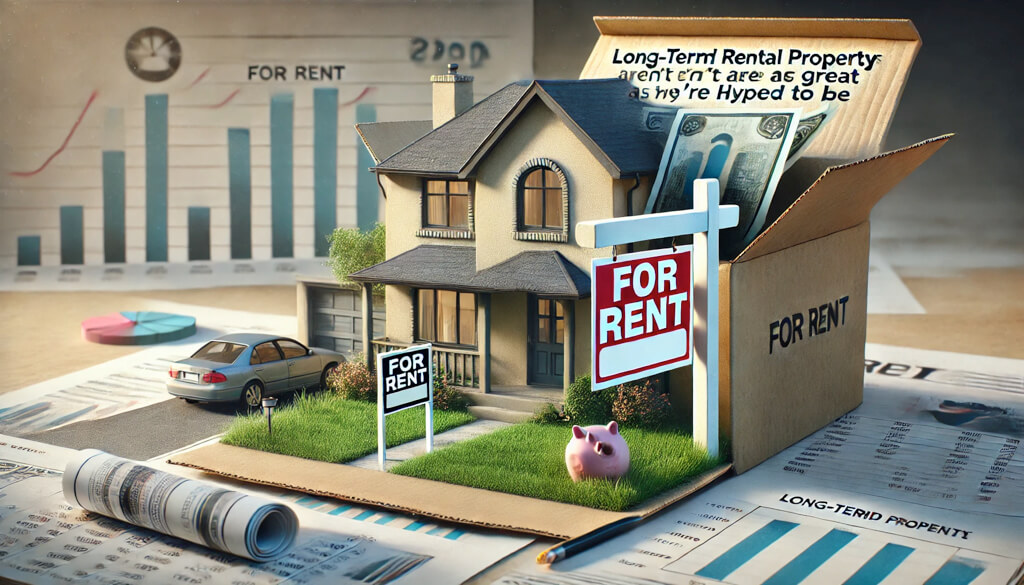
[Image generated with Dall-E]
Long-term rentals may disappoint if you don’t consider three key factors: long-term rent growth, appreciation, and the tenant segment the property attracts. In this post, I will describe two common ways to fail with long-term buy and hold.
Choosing Properties Based on Initial Return Metrics
Many people base their purchasing decisions solely on ROI and cash flow. However, these metrica only predict performance under ideal conditions on the first day. They do not indicate how the property will likely perform in the future. Considering that you’ll likely hold the property for the rest of your life, what happens on the first day is not that relevant, particularly in a world where inflation is constantly eroding the dollar’s value.
I will compare two properties to demonstrate why a property with excellent ROI and cash flow can still be a poor investment.
Property A:
-
Rent: $1,500/Mo
-
Initial ROI: 4%
-
Rent growth rate: 1%/Yr
Property B:
-
Rent: $1,500/Mo
-
Initial ROI: 0%
-
Rent growth rate: 7%/Yr
I will assume an average 3.75% inflation rate over the ten-year period.
Next, I will calculate the inflation-adjusted buying power of the rent over a ten-year period relative to initial buying power. The formula to calculate future buying power is as follows:
- FV = PV x (1 + Growth Rate Percent)^Years / (1 + Inflation Rate Percent)^Years
For example, to calculate the future buying power relative to an initial rent of $1,500 after five years, with an annual rent growth rate of 1% and inflation at 3.75%, do the following:
- FV = $1,500 x (1 + 1%)^5 / (1 + 3.75%)^5 ≈ $1,311
Below, I’ve calculated the annual buying power relative to the initial rent of $1500 per month for the first ten years for both properties.
Property A
Inflation-adjusted rent by year:
| Purchase Year | $1500 |
|---|---|
| 1 | $1460 |
| 2 | $1422 |
| 3 | $1384 |
| 4 | $1347 |
| 5 | $1311 |
| 6 | $1277 |
| 7 | 1243 |
| 8 | $1210 |
| 9 | $1178 |
| 10 | $1147 |
Even though rents increased by 1% per year, they didn’t keep up with inflation. As a result, the amount of goods and services you can buy in the future is less than what you can buy today. So, by basing your purchase decision on day-one ROI and cash flow, you made a huge financial mistake.
Property B
Inflation-adjusted rent by year:
| Purchase Year | $1500 |
|---|---|
| 1 | $1547 |
| 2 | $1595 |
| 3 | $1645 |
| 4 | $1697 |
| 5 | $1750 |
| 6 | 1805 |
| 7 | $1861 |
| 8 | $1920 |
| 9 | $1980 |
| 10 | $2042 |
While Property B started with a 0% ROI, buying power continues to increase over time because rent growth is outpacing inflation.
Real estate is a long-term investment, and making long-term decisions based on day-one performance is almost guaranteed to fail.
Purchasing the Property Before Selecting a Target Tenant Segment
A common mistake is buying a property solely because it seems like a good deal. The reality is that a property never pays rent. The tenant who occupies the property pays the rent. So, the tenant who occupies the property is far more important than the actual property.
Financial independence requires a reliable income. The surest way to secure a reliable income is to have your property continuously occupied by a reliable tenant. A reliable tenant stays for several years and always pays the rent on time. Reliable tenants are the exception, not the norm.
To increase the likelihood of always having a reliable tenant in your property, first identify a tenant segment with a high concentration of reliable people (through property manager interviews). Once you identify this segment, determine what and where they are currently renting and buy similar properties.
The takeaway is to choose the segment with desirable payment behaviors and focus on what they are willing and able to rent. Instead of guessing which property will perform well, find a high-performing segment and let them define:
-
The property type
-
The property configuration
-
The rent range
-
The location
In summary, focus on the people paying the rent, not what you or a guru think is a good property.
Summary
Real estate investing is the easiest type of investment to learn and a proven path to financial freedom for ordinary people. However, people still fail because they make decisions based on the wrong factors.
-
Choose a city where rents have consistently outpaced inflation. This will be a city with significant and sustained population growth. I recommend not considering cities with a metro population of less than 1M.
-
Purchase a property that matches the housing requirements of a tenant segment with a high concentration of reliable individuals. Do not make property selection decisions based on opinions or gurus.
If you don’t adhere to these two investment principles, your chances of long-term success are significantly reduced.






